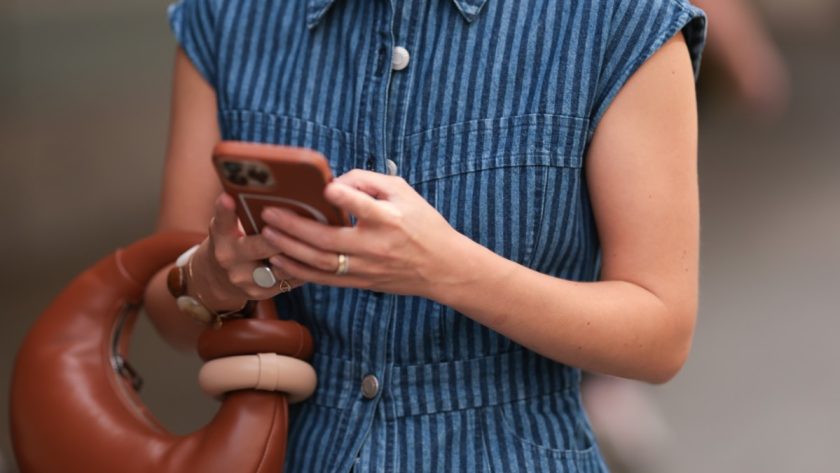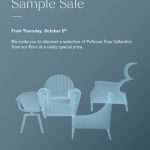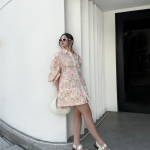Amy Odell was finishing up her second book, “Anna: The Biography,” when she stumbled across a publishing platform called Substack. The veteran author and journalist had long considered launching a newsletter of her own, but didn’t realize until that fateful introduction that she would be able to monetize it, too.
“I felt like there would be a way to talk or write about fashion news that no one was doing yet, and find an audience out there,” says Odell (who first toyed with using a different, more explicitly marketing-focused platform heavily advertising on the first season of “Serial”). “When I found out about Substack, I thought it sounded like a great thing to do because we live in a time where, in media, it’s just so imperative for journalists to have their own audiences.”
In April 2021, Odell debuted “Back Row,” “the ad-free fashion and culture newsletter that publishes what legacy media can’t.” Now more than two years in, “Back Row” and its entertaining, informative commentary have become required reading among industry insiders and outsiders alike, alongside blue-chip publishers perched in their Manhattan skyscrapers, as well as splashy digital media startups, like Puck.
Though an early adopter of the medium, Odell is now not alone as a new generation of journalists are launching their own newsletter efforts, from creative, indulgent personal projects to lucrative financial enterprises — and every rung in between. In Substack’s Fashion & Beauty category, annual recurring revenue and paid subscriptions are up 375% and 213%, respectively, year-over-over, according to the platform.
“Editors are gravitating toward Substack because they want a place to publish their work, explore their creative interests and give space to their own voices, as opposed to a voice that, for many years, was hidden behind the brands they were and are paid to edit,” shares Farrah Storr, head of Substack partnerships in the U.K. and the former editor-in-chief of Elle UK, who also writes the popular Substack “Things Worth Knowing”.
But within an increasingly crowded category, what makes a fashion newsletter actually, well, good? And how can journalists best set themselves up for success when launching their own ventures? We consulted five of the industry’s favorite newsletter authors, as well as Substack itself, to answer just that.
If you’ve been thinking about getting into newsletter publishing, now’s the time
Former Allure and Nylon Editor in Chief (and former Netflix VP of Editorial and Publishing) Michelle Lee turned to Substack this August as a new kind of creative outlet. Despite beginning her career as a reporter, Lee found herself writing less and less as she climbed up the masthead.
Enter “Go Ahead, Try Me,” an in-depth beauty platform intended to “strip away some of the artifice that’s existed in publishing and even on social media.” This, she says, has become something of a golden ticket for the ever-widening entrance into newsletter-dom.
“One big hurdle is that there are a lot of competing goals and interests in publishing right now, between e-commerce, traffic versus engagement, diversification of revenue streams,” says Lee, who recently founded Monologue, a marketing and PR agency for beauty and lifestyle brands. “Editors have to do so much! Editor-run newsletters occupy a totally different space. We’re columnists and subject-matter experts with very specific points of view and, in some cases, extremely senior levels of industry access that people can’t find anywhere else.”
The “math,” if you will, is also totally different: With this immediate divestment from advertisers, editors are granted the luxury of more targeted, and perhaps more thoughtful content. As Lee says, “Building a highly engaged, more niche audience is super valuable when you’re running a ship solo with very little overhead.”
As it turns out, this more intimate community is just as appealing to readers as it is to the editors themselves, particularly in a more thoughtful written-word format. According to Laura Reilly, who introduced her fashion and beauty newsletter, “Magasin,” (pronounced “magazine”) after a three-year tenure working in e-commerce at InStyle, people are seeking out authenticity from those they individually trust. But historically, there hasn’t been a platform to explore that connection beyond glorified sound bites.
“People just want something that feels a little cozier, like the pastoral version of social media,” says Reilly, who now counts “Magasin” as her full-time job. “It’s just an innocent little email that’s reaching your inbox and you can open it or not, but you know it’s not being thrust at you by an algorithm. It’s something you’ve chosen, and you’re going to see only those things you want to see from only those people you want to read them from.”
Keep it unfiltered, curated and — most importantly of all — consistent
The best newsletters, according to Substack’s Storr, have a strong point of view that fosters that aforementioned authenticity readers crave. This is especially good news for journalists, who tend to have strong opinions and the chops to articulate them.
In her role at Substack, Storr advises writers to share those ideas, go deep on their obsessions and cultivate their community by writing about what they truly care about.
“I also warn those editors like myself, who have come from a glossy magazine background, that Substack is a much purer platform,” says Storr. “Rusticity is part of the charm. Your readers are buying access to you and your mind. They want to see the real you.”
Across today’s volatile media landscape, this type of untethered authenticity comes with its fair share of benefits. Hillary Kerr, co-founder and chief content officer of Who What Wear, joined Substack in June 2021 with “Hi Everyone” as a means to exercise her writing muscles in a sort of low-stakes, analog format. Still, unfiltered and well-curated content are not mutually exclusive, and the longtime editor (who began her career at Elle before launching Who What Wear in 2006) has a natural penchant for voice-y, albeit still pristine, reporting.
She offers the example of Maggie Bullock and Rachel Baker’s weekly newsletter “The Spread,” complete with “juicy yarns, big ideas, deeply personal examinations of women’s lives — and none of the advertiser obligations,” as well as Jane Herman’s “Jane on Jeans,” which, Kerr says, gives readers an expert point of view on the denim industry at large.
Then, there’s Lauren Sherman’s “Line Sheet,” a newsletter hosted by Puck that offers incisive reportage on all aspects of the fashion industry. It’s Kerr’s favorite “by a country mile.”
“Talk about a powerful newsletter,” she says. “I get a hit of dopamine every time it drops into my inbox. Sometimes I can’t help myself and read it straight away, but usually I save it until the end of the day, and read in the bath. It’s just a treat, and stuffed with great details and key insights.”
And yet, experts warn, a genuine perspective paired with meticulous reporting means nothing if your readers can’t come to rely on you at whichever cadence you so choose.
“When people ask me for advice about Substack, I always tell them to get ready because once you start, it’s a runaway train,” adds Odell. “I send two emails a week, and it’s a lot of work. If you’re even sending one, it’s still a ton of work. And you’re not just sending the emails, you’re doing the promotion, too. People just have to be prepared for that.”
Should you be charging your readers for a subscription?
The long and short of it is: It’s up to you. But it’s not a decision that editors are making lightly.
Beauty editor and brand consultant Hannah Baxter’s bi-monthly, mental-health-adjacent “Anxiety Beer” and its product-focused sister platform “Beer Face” offer subscription tiers, starting at just $5 a month. Like most Substacks, these ascend up to $225 annually for what’s called “Founding Member” status, where readers can receive personal product recommendations from Baxter upon request, in addition to a suite of other editorial benefits.
Being self-employed, as so many Substack creators are, Baxter explains that it becomes easier to prioritize paid features (like ones that were assigned by an editor for a print or digital publication, for example) over those projects that don’t have direct financial compensation. But when you opt to incorporate monetization into your newsletter model, those priorities shift.
“You’re monetizing your creativity in a way in which it becomes its own entity, and you don’t have as much control over it because you owe your readers that,” says Baxter. “Do you let it become this thing where it becomes a part of your personal brand and a way of making money? Or do you keep it as a passion project? And I don’t think I’ve really figured out what the sweet spot is.”
Still, Baxter says, it’s not as if you can’t derive joy from what you monetize. Storr explains that most editors were raised on understanding, connecting and curating for their audience, and they therefore understand the potential income that Substack can bring when there is a direct financial relationship between editor and reader. It does come with responsibilities, but ones that, theoretically, can be worth the investment.
“Every writer wants to be able to support themselves by writing,” says Baxter. “So get it, girl. Go for it. Monetize that newsletter if that’s what’s making you happy.”
Be prepared for what’s next
“I think newsletters are a bit like podcasts — there’s a low barrier to entry, and everyone has something to say, so they’re easy to start,” says Kerr. “But to keep going and keep the pace? That’s something entirely different.”
Baxter, for one, has concerns about a theoretical saturation point, not from a competitive perspective, but because “there’s only so many hours in the day to read all these.” Ultimately, though, she believes this will push folks to create higher-quality work, which alone may open more doors for editors looking to establish their name independent of publications. We’ve seen this before.
“This phase in media isn’t totally unlike what we saw with blogs,” says Lee. “The most famous bloggers basically grew into solo media empires, branching out into books, TV shows, product lines. Their written content was just one touchpoint. My guess is that we’ll see some of the editor-run newsletters outgrowing the newsletter format and expanding into full-fledged brands. As with everything, if you have a great voice on one platform, chances are, it’ll resonate on others, too.”
On the business side, Lee speculates that newsletter monetization will take on new forms, perhaps in alignment with the consolidation and bundling beginning to take place in the entertainment industry. At some point, she says, asking consumers to buy individual subscriptions to everything may hit a wall. But if you could pay one price to curate your own digital publication and community, with only your favorite, most trusted writers, that could prove to be an appealing concept for writers and consumers alike.
Before that happens, though, editors will resort to joining platforms like Substack in droves — a trend that’s likely to continue if the media industry also continues to hemorrhage its talent. As of June alone, the sector had announced at least 17,436 job cuts, marking the highest year-to-date level of cuts on record, according to a report from executive outplacement firm Challenger, Gray & Christmas. The level of cuts is worse than at the outset of the pandemic in 2020, when 16,750 job cuts were announced through May.
“It’s really, really great for people to be able to support the writers they love in this way,” says Baxter. “Layoffs are a constant struggle. We’re going into the holiday season, when there’s always another round of layoffs. And newsletters are a nice, bright spot to have in a landscape that, for the last 10, 15 years, has been very dark. I feel very hopeful about this space.”
Never miss the latest fashion industry news. Sign up for the Fashionista daily newsletter.



